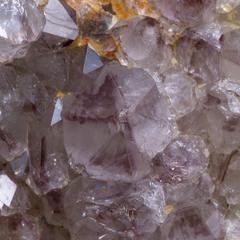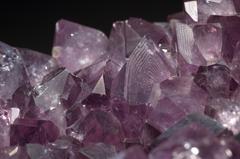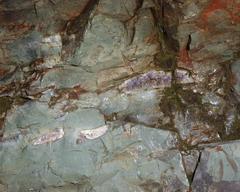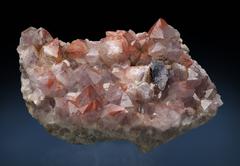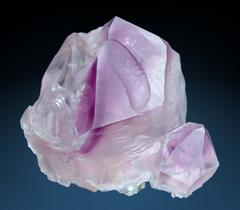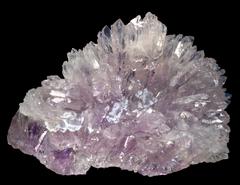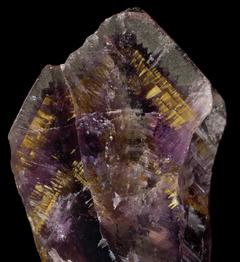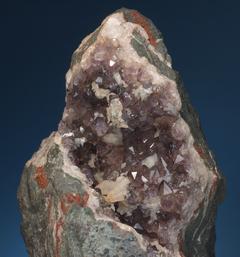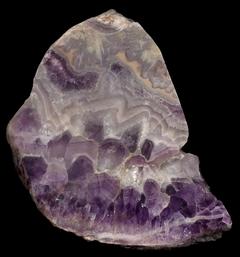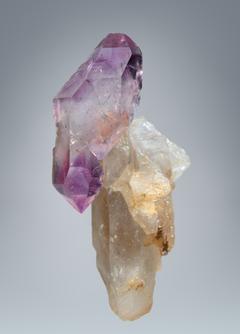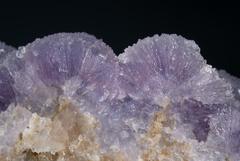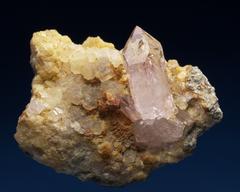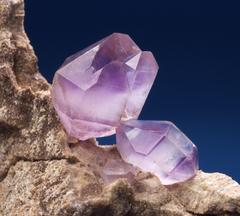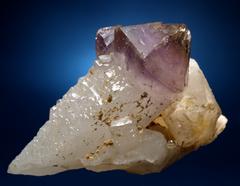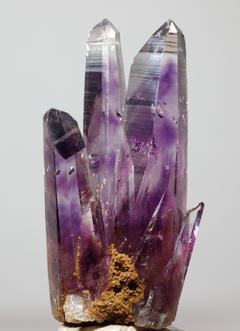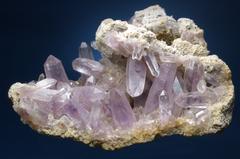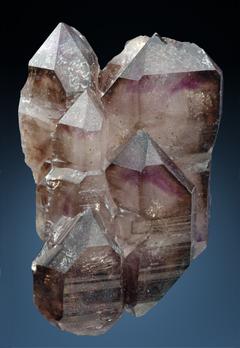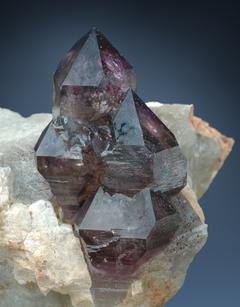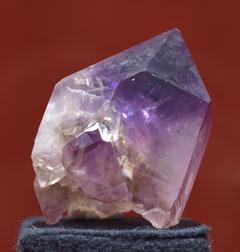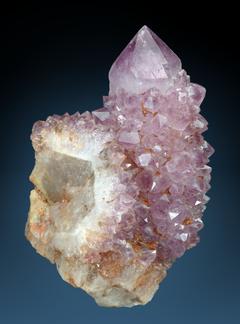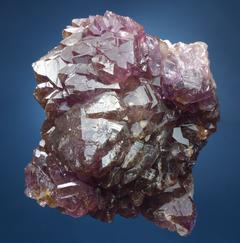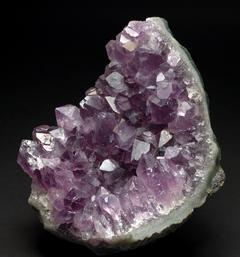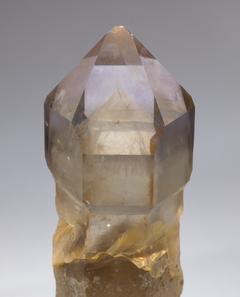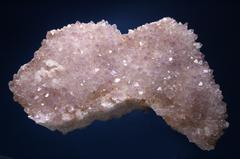Amethyst
Specific Properties
Occurrence
Locations and Specimen
Further Information
Specific Properties
Occurrence
Locations and Specimen
Further Information
Document status: complete
The violet to purple amethyst is the most important and best known gem variety of quartz and has been used for lapidary works since ancient times. Today most amethyst comes from Brazil and Uruguay. Before these resources were discovered, most amethyst was mined in Sri Lanka, India, Germany (Idar-Oberstein region), and the Ural Mountains (Murinska gem region) in Russia.
The name refers to its alleged ability to protect its owner from the negative effects of alcohol consumption, namely "methy", the Greek expression for being drunk, and "a-methy-stos" would translate to "one that does not get drunk"[1]. This association probably came up because of the color of red wine is sometimes similar to that of amethyst.
Specific Properties
Amethyst is a very special quartz. Although it occurs in many different rocks in many different forms, most amethysts share certain basic properties, not just the color.
The color can vary from a pale pinkish violet to a dark blue-violet, with shades of red, and sometimes gray. Very often the color is unevenly distributed or even patchy, and is most intense at the tips of the crystals. Amethyst shows a weak dichroism, with the color changing from gray-violet to purple.
Amethyst owes its color to high energy radiation, e.g. gamma rays from radioactive sources (Berthelot, 1906) and the presence of iron built into its crystal lattice (Holden, 1925). The irradiation causes iron Fe(+3) atoms which probably replace the silicon in the center of the SiO4 tetrahedra to lose another electron and form Fe(+4), an unusual oxidation state of iron (Lehmann and Moore, 1966). Note that the colorizing iron and its precursor is probably not present in the lattice as ideal ions (Fe3+ and Fe4+), but in part bound covalently to oxygen to form a FeO4 group. The electron released from the iron by irradiation is probably taken up by another ion, but there are different models on how exactly the Fe(+4) color center is stabilized. According to a theory of Lehmann et. al., 1973, the electron released from the Fe3+ to form Fe4+ is captured by another Fe3+ elsewhere in the lattice which gets reduced to a Fe2+, so the color center would be a pair of [FeO4]2+/Fe2+ formed in this reaction:
[FeO4]- + Fe3+ → [FeO4]0 + Fe2+
However, other mechanisms including the role of other ions in the charge compensation have been proposed and the details of the nature and formation of amethyst color centers are still a matter of debate. For a review of the different recent theories, see Rossman, 1994, early theories have been discussed by Holden, 1925.
Note: Do not expose an amethyst to direct sunlight for a long time. Very likely it will pale out by the ultraviolet radiation. Some amethyst pales out really quickly and some very slowly, but you can't tell in advance. Even the intense sunlight behind the window in your living room might do some damage, although the ultraviolet components are mostly filtered out by the window glass. This is actually true for all quartz varieties whose color is irradiation-induced (smoky quartz, citrine, pink quartz). In the summer I often cover my showcases with a black cloth.
The color is usually concentrated at the rhombohedral faces, and sometimes is more intense under the r-faces (belonging to the positive rhombohedron) than the z-faces, giving the crystal's tip a pinwheel like appearance when viewed from the top, as can be seen at the specimen of unknown origin to the right.
Sometimes the color is concentrated in zones parallel to crystal faces, giving them a phantom-like appearance. This is due to changes in environmental conditions during growth, namely fluctuations of the iron content and temperature of the solutions the crystals grew in. The picture to the right is a detailed view of crystals from Amatitlan, Guerrero, Mexico, showing multiple "phantoms". You can see that both crystals show a similar color pattern: going down from the tip the distance between the 5 main color patches is "short - long - very short - long". So the pattern reflects environmental changes acting on both crystals simultaneously.
In addition, the left crystal has a diamond shaped negative crystal (a bubble formed like a crystal) with its borders parallel to the color zones. You can see another bubble of similar shape at the right crystal, although a bit out of focus. Both are placed at the same position relative to the color pattern and this might be another effect of changing environmental conditions during growth.
Amethyst can occur in various crystal habits and growth patterns. Some of them seem to be typical for amethyst: Amethyst from druses in volcanic rocks is short-prismatic, the prism faces often do not develop at all. At many locations in igneous and highly metamorphosed rocks (e.g. in the Alps), amethyst grows as scepters on top of rock crystals or smoky quartz. While there are nice examples of relatively elongated amethyst crystals, I've so far not seen or heard of amethyst that formed as needle quartz. Needle quartz grows quickly and that might either inhibit the correct incorporation of iron into the crystal lattice or lead to an inclusion of impurities that suppress the formation of color centers.
As the color of amethyst is caused by iron-based color centers, iron minerals are often companions of amethyst. Of those two, goethite (FeOOH) and hematite (Fe2O3) frequently occur as inclusions.
The crystal form of amethyst (determined by the types of crystal faces that appear on a crystal) is usually rather "boring": you will probably never find any accessorial crystal faces on it. Amethyst crystals are usually simply made up of the prism and the rhombohedra. Especially in amethyst from geodes in volcanic rocks the r-rhombohedron is very prominent, giving the crystals a trigonal appearance.
The likely reason for the simplicity of its crystal form is that most amethyst crystals are heavily twinned in a specific way, called polysynthetical twinning. The crystals are twinned according to the Brazil law, with the left- and right-handed parts of the crystals organized in a layered manner [1].
You can visualize the structure on thin slabs of amethyst with polarized light, or you can etch out the pattern on the rhombohedral faces using hydrogen fluoride[2]. Sometimes you can see that pattern directly on crystal faces, as in the detailed view of an amethyst from Uruguay to the right. Note that the "fingerprint" is visible only on the larger r faces, and not on the z faces. Some authors have even suggested to name any quartz with such a twinning pattern amethyst, no matter what its color might be.
So we might speculate that either
- the traces of iron in amethyst have a much greater influence on growth and crystal structure than the traces of aluminum have in smoky quartz, which does not suffer any restrictions in terms of crystal habit, form, and twinning,
- or the environmental conditions that allow iron to be built into the crystal lattice also lead to a specific twinning pattern and also do not allow accessorial crystal faces to form.
Currently I would favor the second explanation. Artificially grown amethyst does not show a polysynthetical twinning, unless it is grown on top of an accordingly twinned crystal. And there are amethysts which do show accessorial faces, lack polysynthetical Brazil law twinning and even seem to be untwinned altogether in some cases. So the presence of iron alone does not suffice for the twinning to occur.
A very remarkable exception from the "rule of simple crystal forms" is the amethyst found in the Brandberg/Goboboseb area in Namibia, where bipyramidal s-faces and steep rhombohedral faces frequently occur on amethysts. The image shows a small amethyst cluster from a pegmatite or miarole pocket grown on a feldspar-quartz matrix that was found in the vicinity of the Brandberg. One can see two elongated s-faces in the center of the group and a diamond-shaped s-face on a small crystal to the right. This was the first amethyst specimen I got with s-faces on it. The crystals contain numerous inclusions of red and black hematite.
The Namibian locations appear to be the only places where amethyst with accessorial faces is found frequently. Rykart reported a single find of amethyst showing s-faces at the Ahrntal, Southern Tyrol, Italy (Rykart, 1995). Mexican amethyst from the Las Vigas area very rarely shows flat rhombohedral faces that separate r- and z-faces (Lieber and Frenzel, 1990).
Occurrence
The most famous and commercially important amethyst locations are in volcanic rocks. The image shows elongated former gas cavities filled with quartz varieties in the Steinkaulenberg mine at Idar-Oberstein, Germany. The largest cavity is outlined with amethyst crystals. The host rock is a dacite. Initially, only agate and jasper were exploited and the amethyst was left in the rock, because the miners had no technical means to cut amethyst jewels. The field of view is approximately 75 cm.
Amethyst is also found in igneous, and certain metamorphic rocks, as those contain enough radioactive trace elements for a sufficient irradiation of the crystals. Amethyst from sedimentary rocks is very rare, and the crystals are usually very pale in color. As the ubiquitous iron is built into the crystal lattice, amethyst is sometimes found in ore deposits. However, to be built into the quartz crystal lattice, the iron needs to be present as Fe3+, and not as Fe2+. Amethyst can probably not form in watery solutions that contain a large amount of reducing agents, like H2S or methane, CH4, as these would either stabilize Fe2+ or reduce Fe3+ to Fe2+. Oxygen present in the watery solution will cause the formation of Fe3+. For example, in many ore deposits the minerals in the part that came under the influence of meteoric waters have been altered and oxidized, and because of its rusty overall appearance, this part is called an iron gossan. One might speculate that amethyst scepters that seem to form at a later stage and lower temperatures (which translates into "nearer to the surface") than the underlying crystal also formed under the influence of oxidizing meteoric waters.
This is an example for amethyst from low temperature hydrothermal veins. The crystals are from a cavity in massive green fluorite. In addition to the pale amethyst color, there are superficial inclusions of hematite as dark spots and as finely dispersed red cover. To the right there's a blue-green fluorite that got damaged when opening the pocket because it was attached to the opposite wall. From Grube Clara, Oberwolfach, Schwarzwald, Germany.
Locations and Specimen
Amethyst is found at many places all over the world. Today the economically most important producers of gem amethyst are Brazil and Uruguay. Amethyst is also commercially mined in Canada, Pakistan, Madagascar, or Finland, just to name a few countries.
You'd be surprised to see how difficult it is to get a hold of an amethyst from the European Alps. Here amethyst occurs only at a few spots, mostly as scepters grown on rock crystals, or as scepter- and skeleton quartz aggregates.
Afghanistan
Double terminated amethyst crystals from Maquar, Zarkishen Mountain, Kuh-i-Sulaiman Mountains, Ghazni Province, sit in a Calcite matrix. Their color is usually very dark, with a slightly brighter and more milky prism.
Austria
The most famous amethyst localities in Austria are in the Zillertal Alps, a mountain chain bordering Italy at the southern end of the Zillertal valley in Tyrol. Amethyst from this location once used to be cut for jewelery, but now the prices for good Zillertal specimen by far surpass the value of even an excellent cut stone from Uruguay.
Alpine amethyst seems to have been formed mainly as scepters as a second generation on older quartz crystals. They grew probably in a cooler solution than the old crystals. Amethyst from Alpine locations is said to pale more quickly in sunlight.
An amethyst scepter on top of a colorless quartz from the Mörchnerkar in the Zillertal, Tyrol, one of the few productive areas for amethyst in the Alps. You still need to be very lucky to find one, and good specimen carry a hefty price tag.
This is an unusually large and dark amethyst also from the Mörchnerkar area in the Zillertal. The picture was shot at an exhibition during the "Mineralien Hamburg" show 2004, so don't expect to find anything this large yourself.
Only the very tips of these parallel grown skeleton quartz crystals from the Gigalitz near the Floitenkees in the Zillertal show an amethyst coloration. The association of skeleton growth and amethyst color zones is not uncommon.
Another example of a combination of scepter-like and skeleton growth forms and zonar amethyst color. From the Mörchnerkar area in the Zillertal. The crystals have a slightly rough surface and are not perfectly clear, but the color is quite deep for its size. The irregular shape at the left side of the specimen and the kidney-shaped indentation on the large rhombohedral crystal face are not damages but typical skeleton quartz growth forms.
Brazil
Immigrants from the Idar-Oberstein area in Germany were the first to systematically exploit the agate and amethyst deposits in Brazil and Uruguay in the early and mid 19th century. Most amethyst comes from Rio Grande do Sul, where it is found as crystals outlining gas cavities in basalt, forming nice and sometimes quite large druses.
This large gas cavity with its three "fingers" covered with dark amethyst crystals has been worked out of basalt in Rio Grande Do Sul. Seen at the "Mineralien Hamburg 2004" mineral fair.
Between Iraí and Planalto, Rio Grande do Sul, flower-like groups of prismatic amethyst crystals can be found in cracks in basalt. The color of the crystals is usually pale with shades of pink. The bluish patches in the center of the "flower" are chalcedony. The crystals of trigonal habit are shiny but distorted and show stair-like patterns on the rhombohedral faces similar to the ones frequently seen on pink quartz.
Dark amethyst scepters with an icing of "Conchinit", actually Hematite, Fe2O3, from the Mina Conselneiro, Pena, Minas Gerais (so it is not from Rio Grande Do Sul as most Brazilian amethyst). The specimen is probably from an igneous rock or pegmatite deposit.
Amethyst from a druse with goethite, FeOOH, inclusions, Rio Grande do Sul. As mentioned earlier, inclusions of iron minerals can frequently be found in amethyst. The crystals have well developed prism faces, which is not common on amethyst from volcanic druses, and show a patchy distribution of color. The goethite inclusions form very typical bundles of yellow to brown needles that look a bit like a broom (second picture).
One half of a vertically cut amethyst crystal with epitactically intergrown inclusions. Golden v-shaped brooms made of goethite, FeOOH, have grown perpendicular to the rhombohedral faces. The goethite grew in two phases reflecting the changing environmental conditions, and judging from the parallel banding of the brooms, each phase has by itself been very unsteady. The final inclusions are made of an unknown greenish mineral. Except for being from Brazil, I don't know the exact origin of the crystal.
Canada
One of the few areas in western countries where amethyst is commercially mined is the Thunder Bay area at Lake Superior in Ontario, Canada. However important this location may be, very few specimen have made it to fairs on this side of the Atlantic, so I have to apologize for the lack of images and can only point you at related web sites:
Ontario Amethyst - Ontario's Mineral Emblem,
in particular: Ontario Amethyst - Geology of Amethyst in the Thunder Bay area
An image at the Caltech site that gives you an idea of the crystals' size
Many amethysts from the Thunder Bay area bear inclusions of red hematite in the out-most layers of the crystals, like this specimen. The red "caps" on the violet crystals give them a very peculiar look. The hematite cap is not a continuous layer, but is made of small, circular, and flat inclusions.
Finland
There is an amethyst mine in northern Finland, running its own web page in Finish, English and German: www.amethystmine.fi.
Germany
The Idar-Oberstein area used to be a major source of gem quality amethyst until German emigrants started to exploit South American sources in the 19th century. Today, there is no commercial mining of amethyst or agate in Germany, just a few fee-collecting sites where rockhounds can try their luck.
The Juchem quarry at Niederwörresbach north of Idar-Oberstein is probably the best-known fee-collecting site in Germany. It is mined for volcanic rocks (andesite, dacite, basalt), but on the weekends rockhounds are allowed in. One can find agate, amethyst, calcite, and smoky quartz, but the prospect depends on the actual mining situation in the quarry, and good quality amethyst is rare. Nevertheless, the quarry attracts rockhounds from quite a distance, even from the Netherlands. Should you plan to go there, I would recommend to bring heavy tools, including a medium sized sledge hammer, and to lower your expectations.
A typical example of an amethyst geode from the Juchem quarry at Niederwörresbach. Note its round, egg-like shape and the white coating. The white color is caused by partially weathered agate.
This is a small druse from the Juchem quarry that developed in a gas cavity in dacite, with pale amethyst crystals growing on a thin layer of agate. It was partially filled with calcite that has been dissolved. Its egg-like shape is typical for small to medium-sized geodes in volcanic rocks.
This specimen is from an irregular geode that formed in a crack inside basalt. It is from the Mannbühl quarry in Dannenfels, east of the Donnersberg in the Pfälzer Wald. The amethyst crystals are a little grayish due to many goethite inclusions and coatings. The crystals are short-prismatic, some of them double-terminated. The white crystals are calcite.
Amethyst-quartz consists of several generations of amethyst crystals that have grown onto each other, it usually does not show any free crystal tips. It occurs as vein fillings in cracks in various rocks, often in ore deposits. In the upper part of the specimen there are banded vein agate fillings and pseudomorphs after an unknown mineral. One can also see the zonar color distributions that is so typical for amethyst. The specimen is from Geyer in the Erzgebirge mountains, Saxony.
Greece
Greece is more famous for its prase location, Serifos, but one can also find nice amethyst on this island.
Recently finds of amethyst and smoky quartz have been reported from the alpine-type fissures at the southern slopes of the Rhodopes mountains in northern Greece, bordering Bulgaria.
A very nice amethyst scepter sits sideways on an older smoky quartz prism. The scepter shows a very pronounced zonar coloration with a milky core and amethyst color under the rhombohedral faces and a few red flakes of hematite.
The specimen came from an alpine-type cleft near the village of Dasoto in the Kato Nevrokopi Basin, Drama, Northern Greece. Donated by Anastasios Tsinidis.
These amethyst crystals contain inclusions of red and shiny, elongated flakes of hematite. They point roughly in the direction of crystal growth. This is not uncommon in amethyst, although goethite needles can be found much more often. Like the former specimen, it is also from an alpine-type cleft near the village of Dasoto in the Kato Nevrokopi Basin. Donated by Anastasios Tsinidis.
Hungary
Very unusual amethyst comes from Nyíri in the Zempléni Mountains, Borsod-Abaúj-Zemplén County, in Hungary. From the distance it looks like botryoidal chalcedony of amethyst color, but it is made of radially grown amethyst crystals. The crystal aggregates have a silken shine and are translucent.
A close-up of the previous specimen, showing the radially growing amethyst crystal aggregates.
Italy
Amethyst from Osilo on the island Sardinia has made its way into many collections. Not related to any of Sardinia's famous ore deposits it is located in a young volcanic landscape near Sassari in the northern part of the island. The amethyst is found in greenish trachyte layers in quarries in the vicinity of the village of Osilo. The amethyst bearing rock is soft and almost crumbly, so collecting is not too hard [3]. Amethyst typically occurs in small gas bubbles along with yellow, white, or greenish calcite, and brown siderite.
Osilo amethyst appears as small (usually well below 5 cm), prismatic crystals of various habits. Individual Crystals are common, groups of parallel intergrown crystals can also be found.
The crystals are very evenly colored, although usually not very deeply. Many crystals are clear and transparent, but I've also found some odd-shaped translucent crystals. If the color was more intense, one could - at a first glimpse - mistake the specimen for Las Vigas amethyst, as in both cases the prismatic crystals sit on a greenish matrix rock.
Crystals can be hexagonal prisms with both r and z rhombohedral faces, or trigonal "Muzo-like", with distorted prisms and only r faces present.
Many crystals show signs of fenestration or "skeletized" rhombohedral faces. Even more interesting are some odd-shaped "telescope" scepters (inverted scepters, with the next generation of crystals being more narrow than the preceding one).
The first image shows a small, evenly colored skeleton amethyst on a calcite and siderite matrix.
A nice group of parallely grown amethyst crystals can be seen in the next picture. The matrix is covered by pale gray-green calcite, and some of the crystals are found on the amethyst crystals. These crystals are unusually large for Osilo.
Below a few groups of parallel-grown amethysts with reversed scepter habits, again surrounded by calcite crystals.
The last image shows single reverse scepter crystals that are partially covered by brown calcite crystals and some siderite.
Kazakhstan
Very beautiful amethyst is found at the west coast of Lake Balkhash, near Preozersk, Dzhezkazgan Oblast. Small individual short prismatic crystals sit on a quartzite matrix, often accompanied by much smaller quartz crystals. The prisms of the mostly double-terminated crystals are almost white, whereas the tips are intensely colored. The look of good specimen is as distinguished as that of Mexican amethyst.
Madagascar
The area around Lac Alaotra in central Madagascar and the area along the northeastern coast are a source of amethyst scepters. The amethysts from the central part probably all come from pegmatites, while the amethysts from the north eastern region are found in veins and vugs (some of which are said to be similar to alpinotype vugs) in gneisses.
The specimen to the right is from Andilamena, north of Lac Alaotra. The scepter itself only shows very small m-faces (leading to a short-prismatic habit) and the former prism-faces (or m-faces) of the first generation crystal are covered by small white crystals of similar habit that are oriented parallel to the scepter.
Interesting amethysts with multiple phantom-like color zones come from the area around Ankazobe. They show a Tessin-like habit and the color phantoms are confined to the center of the prism. Most phantoms appear cloudy and not very well defined like in this crystal. An exception from that rule can be seen in the growth forms chapter.
Mexico
Some of the nicest amethyst comes from Mexico. Two spots are really famous: Amatitlan, Guerrero, and Las Vigas, Veracruz. Mexico's amethysts are rarely used for jewelery, though, because deeply colored crystals suited for lapidary work are much too rare. Amethysts are nevertheless mined by the local population and sold as specimen to collectors and traders.
The mountain village Las Vigas (now officially called "Profesor Rafael Ramirez") lies 200 km east of Mexico City in the province of Veracruz. The exact location is about 15 km north of Las Vigas near the village Piedra Parada.
The first detailed description of the location and its petrology came from ->Lieber and Frenzel. The amethyst crystals grew in pockets in an volcanic rock of andesitic composition. The rock contains many small gas cavities, but the amethyst grew in clefts and vugs, sometimes along quartz veins, and not in geodes, as most amethyst from volcanic rocks do.
Typical Las Vigas amethyst appears as groups of individual prismatic crystals. Unlike the amethyst of most other locations, these really look like rock crystals that turned violet. They are usually transparent, with the most intense color at the tips. Some crystals show a zonar coloration, with violet phantoms inside the crystal. The crystals are mostly small, around 2-3 cm, only rarely they approach 10cm. Both normal prismatic habits and more trigonal habits can be found. All crystals seem to contain small amounts of hematite inclusions, and small fluid inclusions are not uncommon. The first image shows a deep violet group of crystals with normal habit, one of my favorite specimens. The crystals sit on a matrix that is covered by tiny sparkling quartz crystals.
The second image shows a group of elongated crystals with very small z-faces and a "Muzo-like", trigonal habit. The crystals sit on a crumbly, weathered andesite matrix. Note the inclusions of small red hematite flakes at the base of the crystals.
The second famous amethyst locality in Mexico is the village of Amatitlan in the State of Guerrero. A good description of the locality has been written by ->Ontiveros, Wilson and Megaw. The amethyst crystals come from pockets in skarn deposits that formed during the intrusion of a granitic magma into dolomitic limestones and shales. Amethyst of similar shape comes from skarn rocks on the island of Serifos, Greece, and from veins in volcanic intrusions in limestones at the village of Porkura in Romania (->Stöhr), but these locations have produced a much smaller number of specimen.
It's easy to recognize amethyst from Amatitlan. They are mostly translucent, with the most intense color at the prism and the base and white or colorless tips. Usually the violet gets more and more reddish and finally brown towards the base of the crystals. The crystals often grew in small groups that radiate from a common point, and most of them show smaller crystals sprouting from them. Fluid inclusions formed like negative crystals are quite common, and the reflections inside the upper half of the big crystal are caused by a large "negative crystal". A detailed view of the negative crystal is shown in the section Inclusions section.
The next specimen is less typical for Amatitlan amethyst: it is transparent, and the depth of the color is not gradually increasing to the base, but more patchy, forming multiple phantoms. The tips are still colorless. Note the many negative crystal inclusions. The same specimen is used to demonstrate zonar coloration on top of this page.
This specimen has been labeled "Urugua Amethyst, Mexico". While Mexico sounds reasonable, I couldn't find out anything about "Urugua". The crystals are a bit pale, with the most intense color located phantom-like inside the prism, so Guerrero might be a good guess.
On mineral fairs one can frequently see traders that have piled up hundreds of ball-shaped and still closed coconut geodes and offer some sort of "open-you-own-geode service". These geodes have probably collected from crumbly weathered volcanic rocks in and around the Sierra Gallegos near Las Choyas, Chihuahua (the geodes are sometimes named Choyas geodes). This is one of the most productive areas for geodes in the world. Most material comes from the farm Rancho Mesteno.
The geodes will contain colorless quartz, smoky quartz, agate, calcite or amethyst. A distinguishing feature of the geodes is an outer layer of dark brown calcite and a bright, almost powdery coating of weathered volcanic tuff. The specimen to the right is a medium-sized geode that has an outer shell of brown calcite, followed by layers of bluish chalcedony and colorless quartz with violet tips.
Namibia
A scepter amethyst with skeleton growth and water inclusions from the Brandberg mountains. Some of the small water bubbles can be seen in the central part of the crystal. The combination of scepter and skeleton growth is quite common for amethyst from the Brandberg and also for those from the nearby Goboboseb Mountains. It can also be frequently observed in Alpine amethysts.
A smoky quartz with amethyst colored zones from a pegmatite or miarole in granite (on the flip side there are traces of orthoclase feldspar and epidote). There are numerous fluid inclusions as well as thin needles and flakes of hematite in the crystal, well visible in the lower right crystal. Bought in Uis, from the Brandberg area, possibly from a pegmatite deposit north-west of the Brandberg.
These parallel grown dark amethyst scepters form the extension of a milky quartz prism in a quartz orthoclase matrix (pink and reddish crystals). It is very likely from a pegmatite in the Brandberg area.
A small group of parallel grown amethyst crystals sits on a granite matrix. The crystals contain numerous inclusions of red hematite flakes. Note the small shiny s-face with its typical striations left of the center of the image; so far the Brandberg area and the neighboring Goboboseb mountains are the only locations where amethyst can be found with accessorial faces. Probably from a miarole pocket in the Brandberg area.
There is a nice gallery of Namibian amethysts and quartzes at http://www.mb-minerals.de/.
Nigeria
This is so called amethyst-quartz from the Jos Plateau in Nigeria. Several generations of amethyst crystals have formed layers in a crack that reflect periodically changing growth conditions. Similar specimen can be found at many other locations, for example Saxony, Germany.
Norway
Norway has a couple of amethyst locations that in some respect resemble those in the Alps. Short-prismatic crystals and scepters are most common.
The image shows short-prismatic crystals associated with dolomite and pyrite from Stange, Hedmark, east of Lake Mjøsa in Southern Norway.
A small amethyst scepter sits between smaller elongated quartz crystals. The color is concentrated under the rhombohedral faces. Its origin is only about 20 kilometers west from that of the former specimen, it is from Toten, east of Raufoss, Vestre Toten, Oppland, west of Lake Mjøsa in Southern Norway.
If you want to see more, you should have a look at Kai Helge Andersen's mineralcollector page, who has quite a few amethysts on display, most of them from Norway.
Pakistan
This piece from Wana, Waziristan, has probably been first partially dissolved and later healed, resulting in the mosaic-like surface structure. A similar pattern can be seen at a corroded smoky quartz from Shigar Valley, also in Pakistan, at the "Growth Forms" section. This specimen is evenly colored, while others from the same location sometimes show the most intense color along some edges, however still quite pale. Triangular flakes of red hematite can be seen inside the crystal.
Russia
The most important amethyst locations of Russia lie in the Murinska region in the Ural mountains, right next to the even more famous beryl and topaz mines. They have been exploited in the 18th and 19th century, and were once as important as the Sri Lanka, Indian and German sources, until cheaper material started to flow in from South America. The amethyst occurs in pockets inside quartz veins in weathered granite. They resemble amethyst from alpine locations in being short-prismatic, a bit scepter-like, and of an uneven color. From what I have seen so far, the crystals seem to be more idiomorphic than their relatives from the Alps. Some of them have assumed a very deep and good color, like the specimen on the picture from Miass, also in the Ural Mountains. The picture was taken at the Russia Special Exhibit at the "Mineralien Hamburg 2005" fair.
South Africa
Since a couple of years very nice cactus quartz, also known as spirit quartz, from South Africa is frequently offered on fairs. Most of the crystals still have a first generation tip that has not been encrusted by younger crystals. There are white, yellow, and smoky crystals, but pale amethyst seems to be most common. Intensely violet crystals are the most wanted and are more and more difficult to get.
There has been some confusion about the exact location of the specimen. First, "Magaliesberg" was said to be the origin (and there were different interpretations of what "Magaliesberg" actually meant), then, after a few years, the labels on the mineral fairs were changed to say Marble Hall, a small town about 120 km north east of Pretoria. Meanwhile, the location has been corrected again, and is now said to be the area around the former Boutenhouthoek and Mathys Zyn Loop farms, about 45 km south west of Marble Hall, or 80 km north east of Pretoria (Sprich et al., 2003; Cairncross et al., 2004).
So far the "mining operations" are carried out as a subsidiary business by local farmers. The crystals are found in quartz veins in a granitic rock of the well known Bushveld intrusion complex. The host rock is approximately 2 billion years old, but it's not clear when the quartz veins have formed and how old the crystals are.
The first image shows a dark colored specimen with one crystal broken off, so the six-sided prism of the first-generation crystal can be seen underneath the smaller amethyst crystals.
The second image shows a group of medium-sized cactus quartz crystals in the most common lilac color.
Sweden
Ransäter, Värmland
Deeply colored amethyst from a vein in mica schist near Torsby, Värmland, about 100km north of Lake Vänern.
Tanzania
The image shows complex intergrown amethyst crystals of artichoke habit from Gailo, Morogoro Mountains. The crystals contain inclusions of irregularly distributed goethite needles.
Uruguay
Uruguay amethyst is renown for its deep color. This specimen is a part of a typical drusy geode from basalt. Its crystals show a polysynthetical twinning "fingerprint" pattern on the r but not the z rhombohedra. A detail view of the pattern is shown on top of this page.
USA
A very pale amethyst scepter sits on a citrine-colored crystal whose tip is still visible as a yellow phantom. On the bottom there is another smoky phantom, although a bit blurred. This crystal is from the ridge of Peterson Mountain (or Petersen Mountain), Washoe County, NV, on the Nevada-California border. The location is better known among rockhounds as "Hallelujah Junction" and is renown for its multicolored quartz crystals. More about this location can be read in the U.S.A. paragraph of the Smoky Quartz section. On the second photo the crystal is shown in front of the pocket it came from.
More images of the deeper colored amethyst scepters from that location can be seen on Kai Helge Andersen's mineralcollector page.
The Kingston Range, San Bernardino County, south of Death Valley, California, is largely composed of granitoid rocks of partially porphyric structure. At the eastern slopes one can find small prismatic quartz and sometimes amethyst crystals in pockets, miaroles and in drusy quartz veins. There once was an amethyst claim, but the amethyst seems to be very sensitive to light and rarely of jewelery quality. Should you plan to go there: this is a wilderness area, so check the actual regulations for outdoor activities first.
The first image shows dark and evenly colored amethysts in a small pocket. The pocket was associated with a quartz vein.
The quartz slab covered with small and pale amethyst crystals came from the same vein that was associated with the specimen in the former image. Different from the crystals in the pocket, these crystals have a more trigonal habit with very small z-faces and are colored at the tips only.
The third image shows prismatic crystals from a druzy quartz vein. Not all crystals in the pockets were violet, some where slightly smoky or colorless.
Another specimen from the same pocket as the one in the previous image. The host rock is a granitoid igneous rock with a porphyric structure. The crystals show split growth at their base. Kingston Range, San Bernardino County, California.
This lilac amethyst is part of a geode from the "Potato Patch" location, at the Hauser Geode Beds, Southern California.
Further Information, Literature, Links
Werner Lieber has written a nice ->book about amethyst, albeit in German. It covers not only the mineralogical aspects, but also the history of amethyst "mining" and includes many pictures of specimen from locations all over the world.
Footnotes
1
Thanks to Anastasios Tsinidis for helping me on this.
2
That′s why it is a bad idea to clean amethyst specimen in an ultrasonic bath. The crystals might part along the twinning planes.
3
Some of you might find it tempting to do some experiments with hydrogen fluoride. Hydrogen fluoride is a very dangerous substance. Just look up a case in a good textbook on toxicology; after the lecture you will not want to touch it even with a pole. The watery solution is not a strong acid (pure HF is), and the undissociated small HF molecules easily penetrate the skin and bind calcium in the cells to form insoluble fluorite, CaF2. Calcium is essential for the live functions of all body cells. A small drop on a finger that goes unnoticed as it does not immediately hurt can - after some delay - cause substantial damage and great pain.
Let′s quickly do the math: 1 Mol HF = 20g. A drop (approximately 50 μl) of a 20% solution contains 0.00005 l x (200g/l) = 0.01 g. 10 mg, that doesn′t sound like much.
1 Mol Ca = 40g and 1 Mol F = 19g. 1 Ca will bind 2 F, thus 40g Ca will bind 38g F from 40g HF. 1 ml of you body tissue contains about 0.1mg Ca, and 0.1mg HF will let it precipitate almost completely. In theory, the 10mg HF in the small drop could precipitate most of the Ca in 100 ml tissue, killing all cells in it.
And no, I am not opposed to water fluoridation (no irony here).
4
Which is not to say that collecting is permitted. I′ve heard contradictory reports about the collecting situation, and my own experiences are mixed as well: one time no one seemed to care, the next time I was not allowed in.


